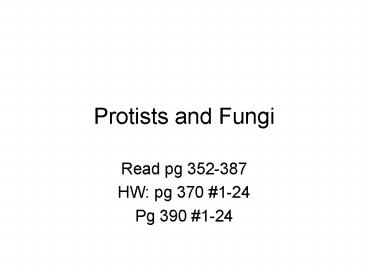Protists and Fungi PowerPoint PPT Presentation
1 / 14
Title: Protists and Fungi
1
Protists and Fungi
- Read pg 352-387
- HW pg 370 1-24
- Pg 390 1-24
2
Protists
- Protists are also microorganisms like Monera.
- However, protists are eukaryotic
- 3 major types
- Animal-like protozoa
- Plant-like protophyta
- Fungus-like slime molds and water molds
- Because of similarities and overlaps, it is hard
to classify protists
3
About Protists
- Protists can be unicellular or multicellular
- Protists are different from other eukaryotes
because they lack specialized tissues. - In other words, they are very simple.
- Protists live in just about any environment that
contains liquid water. - Many are photosynthetic
- Can reproduce sexually or asexually
4
Animal-like protists
- Mostly single-celled and mobile.
- Eat via phagocytosis
- 4 groups arranged by locomotion
- Flagellates having long flagella
- Amoeboids having transient psuedopods
- Ciliates having short cilia
- Sporozoa non-mobile and able to form spores
5
Plant-like protists
- Usually contain chloroplasts (possibly through
endosymbiosis) - Some are truly multicellular (as opposed to
colonial) - 3 major groups
- Chlorophytes green algae (related to higher
plants) - Rhodophytes red algae
- Heterokontophytes brown algae, diatoms
6
Fungus-like protists
- These form spores
- Often feed on bacteria via phagocytosis
- Due to similarities with protozoa and protophyta,
most have been reclassified.
7
Fungi
- Fungi are eukaryotic
- Heterotrophs that have cell walls (although
different from plant cell walls) - Performs sexual and asexual reproduction
- Produces spores from fruiting bodies
- More closely related to animals than plants
- Alongside bacteria, prime decomposers
8
Where are they?
- Examples of fungi include
- Yeasts
- Molds
- Mushrooms
- Found worldwide in soil, dead matter, and as
symbionts of plants, animals, and other fungi.
9
Survival
- Again, found worldwide
- Deserts, salty water, deep sea, on rocks
- Able to survive UV radiation and cosmic radiation
(when taken to space) - Spores
- Spores are contained in the gills of a fungus.
Gills, or lamellae, house the reproductive
spores. A single fruiting body may produce up to
10,000 million spores! - Fungi require wind and gravity to spread spores.
Usually we find fruiting bodies in a fairy ring
due to a growth in all directions from a single
point of germination.
10
Anatomy
- Thread-like filaments are called hyphae
- Interconnected hyphae form mycelium
- Development of spores occur in fruiting bodies.
11
Symbiosis
- With plants Aid in plants ability to uptake
inorganic nutrients. 90 of all plants interact
with fungi. - With insects Several types of ant harvest fungi.
Some beetles and termites also cultivate fungi. - As pathogens Known for affecting many plants and
animals (ringworm, for example is a fungal
infection)
12
Human use
- As fermenters yeasts for beer, wine, bread, soy
sauce. - As food mushrooms, truffles, the blue in bleu
cheese - As medicine producers of antibiotics (penicillin
for example) - Useful in curing tuberculosis, syphillis, and
leprosy - As industrial used to make stonewashed jeans,
industrial chemicals, and as biological
detergents.
13
- Slime molds and Fungus Video
14
Dissections

